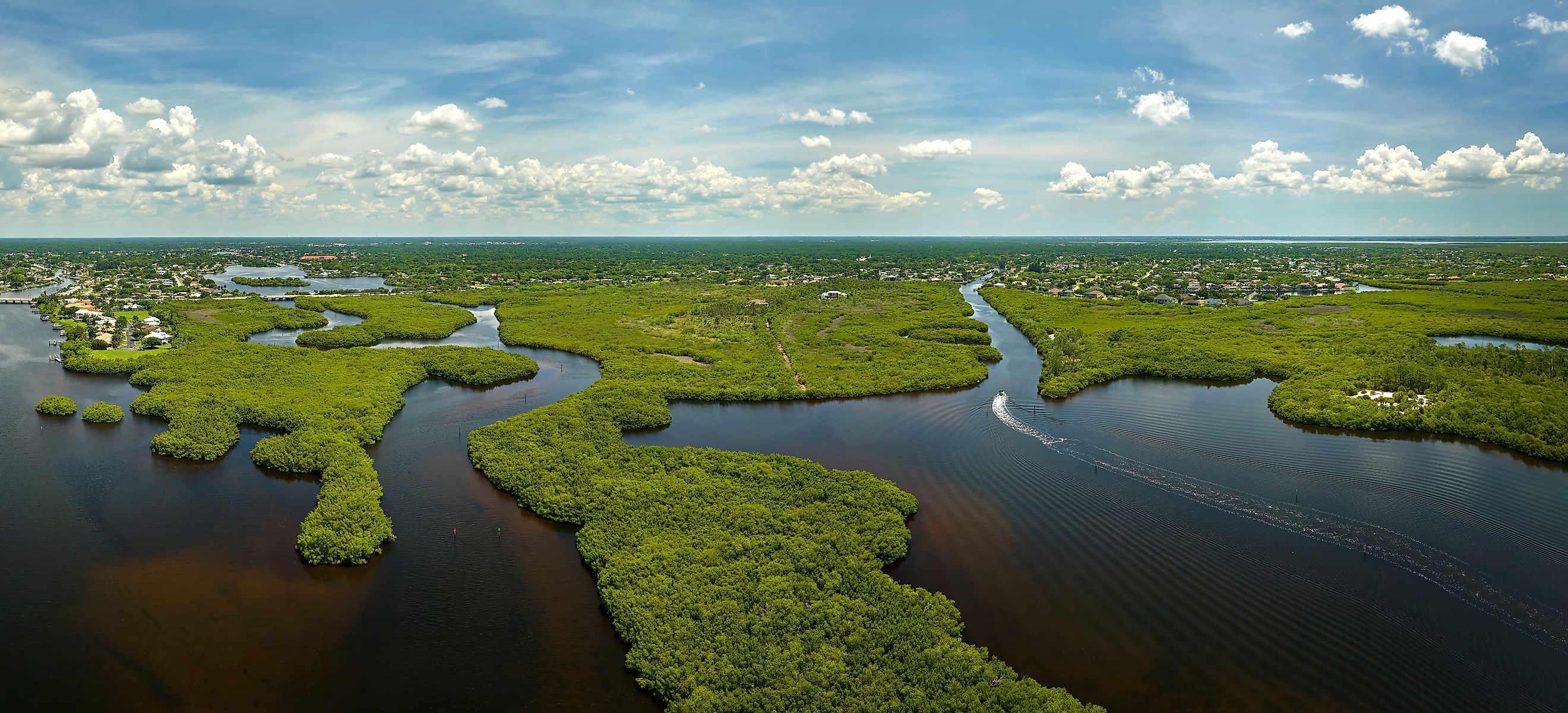
The Natural Wonders of Florida
Florida, also appropriately known as the "Sunshine State," is a state to which millions flock every year for its ideal weather and beautiful landscapes. While many stick solely to the beaches, theme parks, and big cities like Miami, Orlando, and Tampa, the natural wonders that can be found here should not be overlooked and deserve a highlight of their own.
From the massive biodiversity of the Everglades to the tropical delights of the Florida Keys and the often-overlooked central lakes and grasslands, this list is intended to give you a strong starting point for any outdoor sightseeing adventure throughout the state of Florida.
Lake Okeechobee
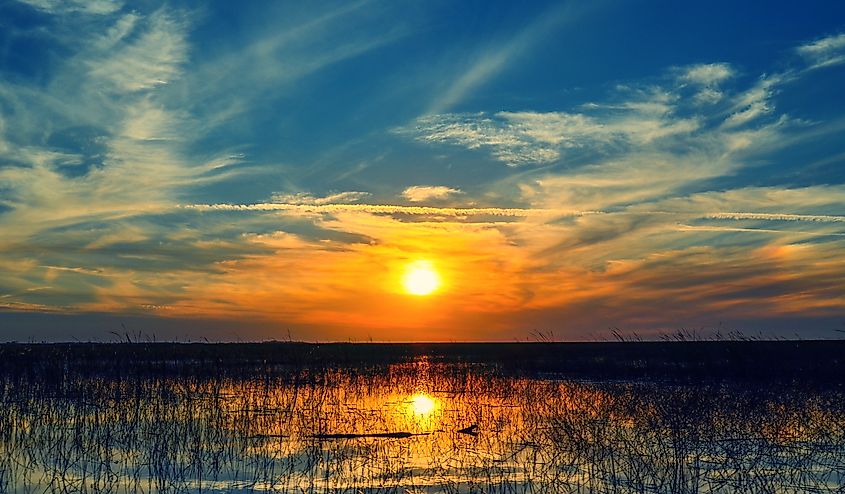
Sunset over Lake Okeechobee in Florida.
Lake Okeechobee is Florida’s largest freshwater lake and the 8th biggest natural freshwater lake in the entirety of the United States. It covers 730 square miles and is in the heart of the state. Lake Okeechobee serves as a crucial water supply for the surrounding areas and plays a significant role in the local ecosystem.
Lake Okeechobee is surrounded by a variety of habitats, including wetlands, marshes, and upland areas, which support wildlife such as alligators, a variety of birds, and freshwater fish. The lake is best known by avid fishermen for its bass fishing, drawing anglers seeking to catch trophy-sized fish from around the country. Boating, birdwatching, and hiking along the scenic lake’s shoreline are also incredibly popular here. be sure to walk along at least one section of the Lake Okeechobee Scenic Trail, which skirts many sections of the lake's shoreline.
The lake is essential to the South Florida Water Management District's water control system, which helps manage water flow and mitigate flood risks. The Herbert Hoover Dike, a massive earthen embankment, encircles the lake and is crucial for flood protection.
Everglades
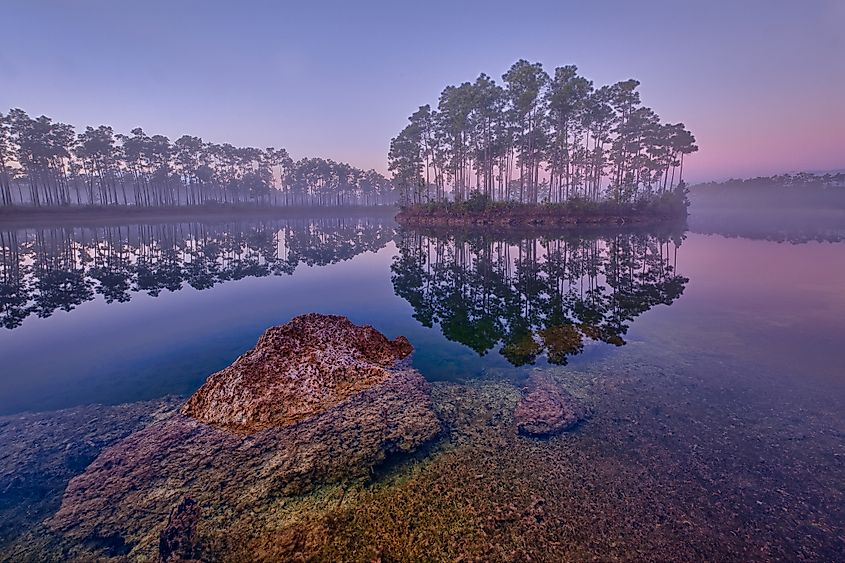
Dawn at Long Pine Key Lake in Everglades National Park near Homestead, Florida.
The Everglades in southern Florida is a vast and unique wetland ecosystem covering approximately 1.5 million acres. This wilderness, accessible via Miami, is characterized by slow-moving waters flowing through sawgrass marshes, cypress swamps, mangrove forests, and coastal estuaries. It is a habitat for a huge diversity of plants and animals, including species like the American alligator, the West Indian manatee, and the Florida panther.
The Everglades is often referred to as the "River of Grass" due to its expansive, grassy-looking landscape. This region plays a very important role in the environment of not just Florida but much of the Gulf Coast as well, acting as a natural water filter and a barrier against coastal erosion. Efforts to restore and preserve the Everglades are ongoing, involving federal, state, and local initiatives. These restoration projects aim to slow down human development, improve water quality, reestablish natural water flow, and protect this ecosystem for future generations.
The Everglades National Park, a UNESCO World Heritage site, attracts numerous visitors interested in exploring its unique landscapes and wildlife. Tour on airboats, along with other craft capable of navigating the swamps, are available through a number of different companies.
Florida Reef
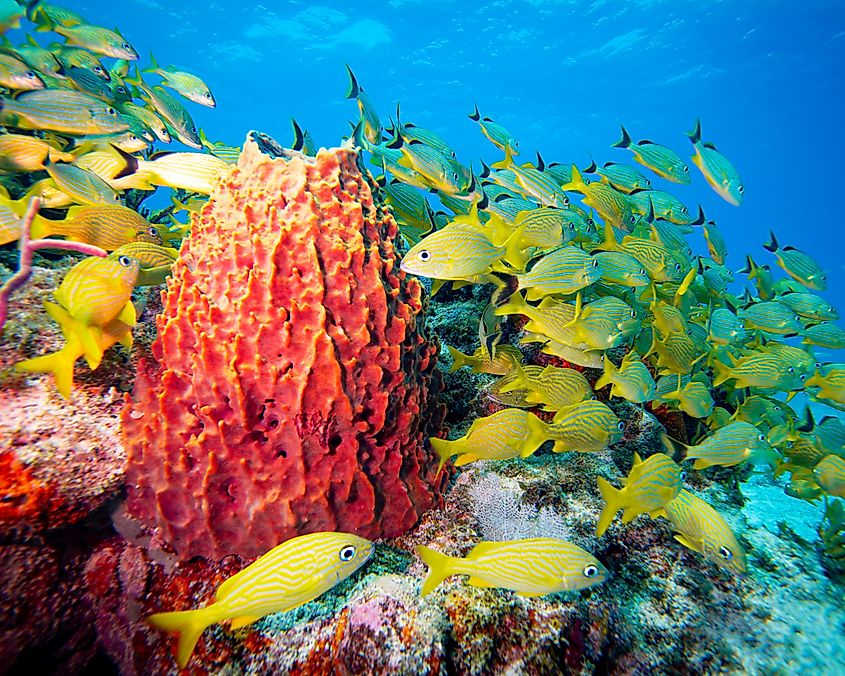
Molasses Reef in Key Largo, Florida.
The Florida Reef, the only living coral barrier reef in the continental United States, stretches for about 360 miles from the Dry Tortugas National Park in the Gulf of Mexico to the St. Lucie Inlet on Florida's east coast. This intricate underwater ecosystem is home to dozens of species of corals and nearly hundreds of species of fish. As a Critical habitat for marine life off the coast of Florida, including endangered species such as the green and hawksbill sea turtles, you should keep in mind the impact of your visit while seeing this natural wonder up close.
The Florida Reef is a popular destination for snorkeling and diving, attracting tourists from around the world who wish to explore its colorful coral formations and have the chance to encounter its marine inhabitants.
The Florida Reef faces significant threats from climate change, pollution, and human activities. Coral bleaching, a result of rising sea temperatures, is one of the most notable risks to the reef’s health and sustainability.
Florida Caverns
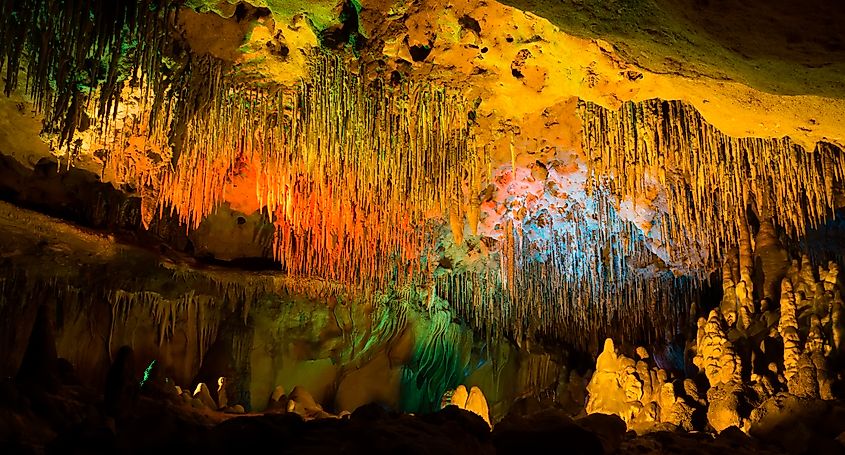
Colored lights illuminate the cave formations at Florida Caverns State Park.
On the Northern edge of the Florida Panhandle, you can find the Florida Caverns, the state's only air-filled limestone cave accessible to the public. These remarkable caves were formed over millennia as acidic groundwater dissolved the limestone bedrock, creating intricate underground passageways and chambers. Stalactites, stalagmites, and other geologic formations decorate the caverns, wowing all who are brave enough to enter.
The Florida Caverns State Park, established in 1942, offers guided tours that will lead you through this subterranean wonder, providing a glimpse into the geological history of the region. Beyond the caverns, the park encompasses over 1,300 acres of diverse landscapes, including hardwood forests, river floodplains, and natural springs. Explore this important landscape through the variety of trail systems that can be found within.
Outdoor activities are easy to partake in in Florida Caverns State Park. Hiking, canoeing, and horseback riding are popular, while the Chipola River, flowing through the park, is ideal for fishing and boating. The park also contains useful amenities like picnic areas, a campground, and an interpretive center, where you can learn more about the park and its surrounding area.
Biscayne National Park
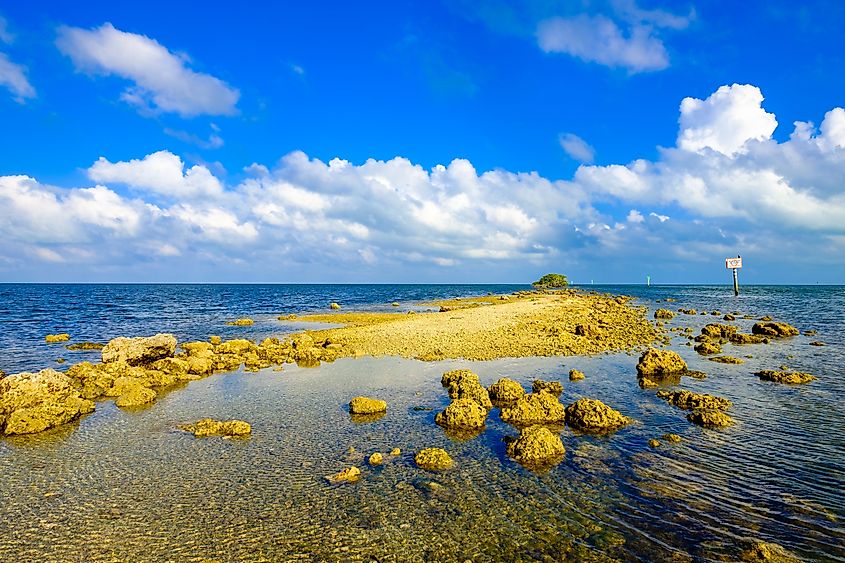
Stunning view of Biscayne National Park from Black Creek Trail.
Biscayne National Park makes for a fun and interesting natural excursion near Miami besides the Everglades. It is a vast marine park encompassing approximately 173,000 acres of coral reefs, mangroves, and seagrass beds. It stretches from the northern edge of Biscayne Bay to the southern boundary of the Florida Keys, including a significant portion of the Florida Reef.
On your visit here (and if you want to get in the water), be sure to explore the coral reefs and see the numerous fish, sea turtles, and other marine species through snorkeling and scuba diving. Are you a landlubber? Don't worry, as you are free to walk the trails in and around this park's extensive mangrove forests. The park's remote barrier islands, such as Boca Chita Key, offer opportunities for camping and solitude.
Biscayne National Park is also home to a good collection of notable historic sites, including the Cape Florida Lighthouse on Key Biscayne, which is perfect for panoramic views of the surrounding waters. Come for a sunrise or sunset and have your camera ready!
Access to Biscayne National Park is available via boat from the Dante Fascell Visitor Center on the mainland.
Devil's Den
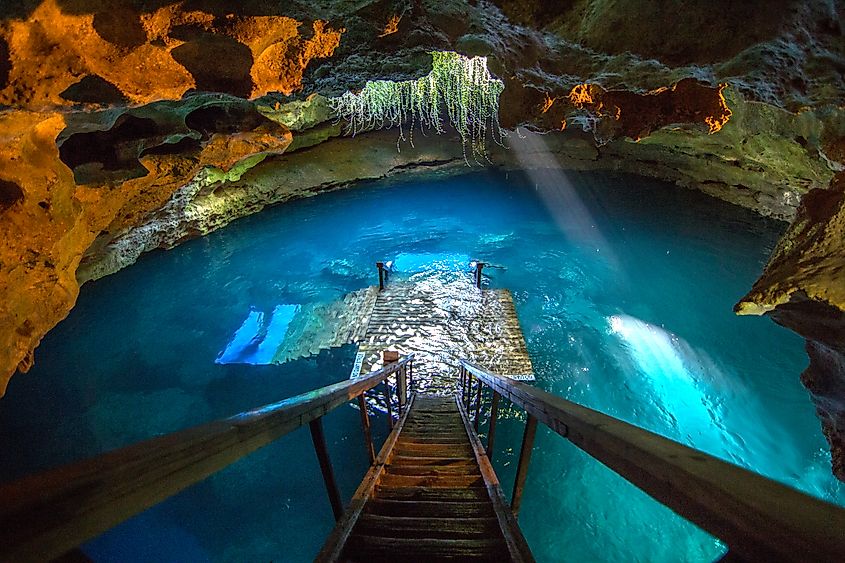
Devil's Den Spring in Florida.
Just south of Gainsville is the ominously named Devil's Den, a prehistoric underground spring and one of the state's most unique natural attractions. The spring is housed within a dry cave, creating a slightly claustrophobic yet beautiful environment where crystal-clear water meets ancient rock formations. The den gets its name from the early settlers who saw steam rising from the cave's chimney-like opening on cold mornings, resembling smoke from a devil's lair.
The spring maintains a consistent temperature of 72°F year-round, making it an ideal spot for snorkeling and scuba diving. Divers can explore depths of up to 54 feet, where fossil beds that are over 33 million years old can be seen. The clear waters offer excellent visibility, allowing for an immersive experience among the limestone formations found within
Devil's Den is part of a privately owned recreational facility that includes cabins, a campground, and other various amenities for visitors. The site also provides educational opportunities through tours and exhibits, with its longstanding history and unique geology serving as a fascinating backdrop for learning about Florida's natural heritage.
Blue Spring
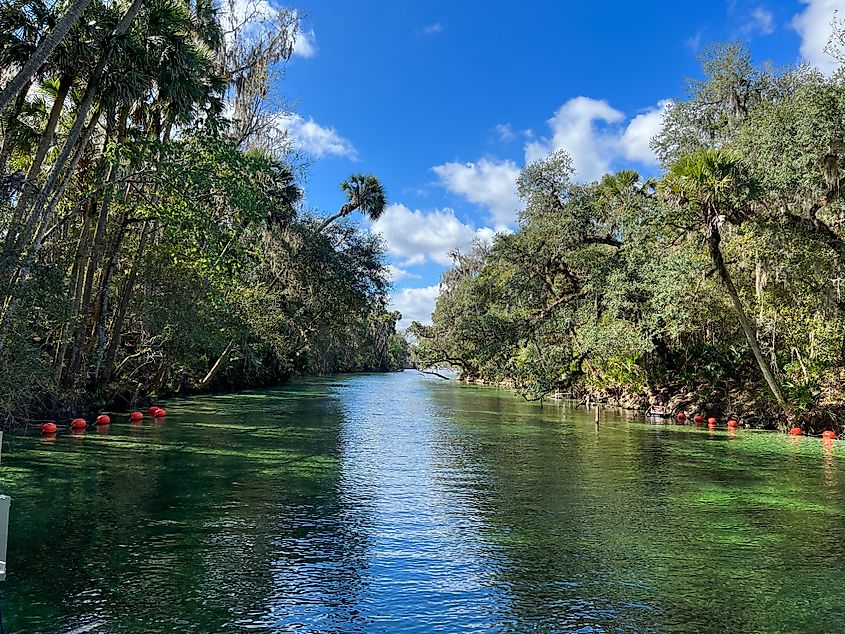
The springs at Blue Springs State Park in Orange City, Florida.
Blue Spring State Park, an easy drive north of Orlando, is best known for the park's centerpiece, Blue Spring. This is the largest spring on the St. Johns River, discharging 104 million gallons of water daily. The spring's crystal-clear, relatively warm waters attract visitors for swimming, snorkeling, and diving during the warmer months of spring, summer, and fall.
One of the park's most notable features is its role as a winter refuge for the West Indian manatee. From mid-November through March, hundreds of manatees gather in the warm spring waters, giving viewers a spectacular opportunity to see these majestic animals. Elevated boardwalks along the spring run provide excellent vantage points to observe these manatees.
Besides manatee viewing, Blue Spring State Park is a hotbed for canoeing, kayaking, and fishing, activities that are primarily popular on the St. Johns River, while the park's trails are splendid for hiking and wildlife watching. The park also includes picnic areas, a campground, and historic sites, such as the Thursby House, built in 1872, making it a great destination for those who want to break free from the crowds at nearby Disney or simply want a natural retreat while in the Orlando area.
Florida Keys
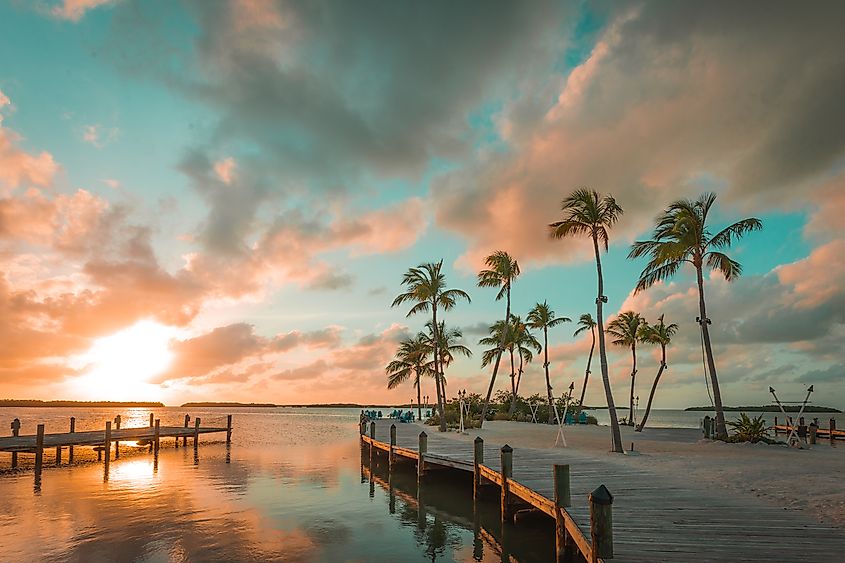
The Florida Keys, an archipelago stretching about 113 miles off the southern tip of Florida, are a top destination for getting a taste of some of Florida's most iconic environments, cultural attractions, and historic landmarks. Comprising over 1,700 islands, the Keys are divided into five main regions: Key Largo, Islamorada, Marathon, the Lower Keys, and Key West.
Key Largo, known as the "Diving Capital of the World," features the John Pennekamp Coral Reef State Park, the first underwater park in the United States. Islamorada, on the other hand, is celebrated for its sport fishing and attracts anglers from around the globe who want to go on either private or guided expeditions. Marathon is famous for its more family-friendly atmosphere and the Seven Mile Bridge, a marvel of engineering connecting the Middle and Lower Keys.
The Lower Keys, including Big Pine Key, offer a more tranquil and less visited environment, with the National Key Deer Refuge being a popular natural environment in which to find solace. Key West, the southernmost city in the continental U.S., has a lively artistic community, historic sites like Ernest Hemingway's home, and a robust nightlife on Duval Street, which is lined with many excellent restaurants, bars, and clubs.
Blowing Rocks Preserve
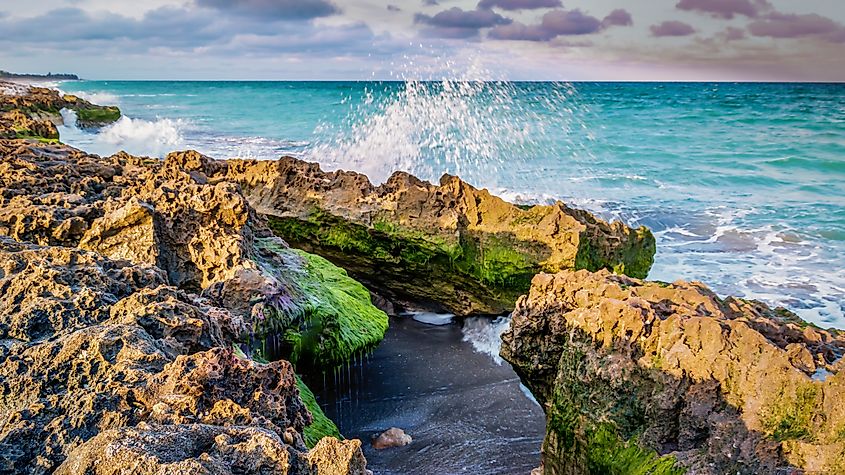
Sitting on Jupiter Island on the east coast of Florida, Blowing Rocks Preserve is a picturesque coastal sanctuary known for its dramatic limestone shoreline. Managed by The Nature Conservancy, this 73-acre preserve features the largest outcropping of Anastasia limestone on the U.S. Atlantic coast. The eye-opening rock formations that call this preserve home, carved by millennia of wave action, create blowholes that can spray seawater up to 50 feet in the air, particularly during high tide or stormy weather.
The preserve's beach is a haven for nature enthusiasts, offering the best view of the limestone formations and insight into how Florida's coastlines were (and still are) created. The rocky shore is interspersed with sandy stretches, providing habitat for various shorebirds and nesting sea turtles, too. You are allowed to explore the preserve through a series of well-maintained trails and boardwalks that meander through hammocks and mangrove wetlands nearby.
Blowing Rocks Preserve is also dedicated to conservation and education, with programs and guided tours to highlight the importance of coastal preservation being offered by park officials regularly. The Hawley Education Center at the preserve provides further exhibits and information on the local plants and wildlife, as well as the ongoing efforts to protect this natural area.
Gulf Islands National Seashore
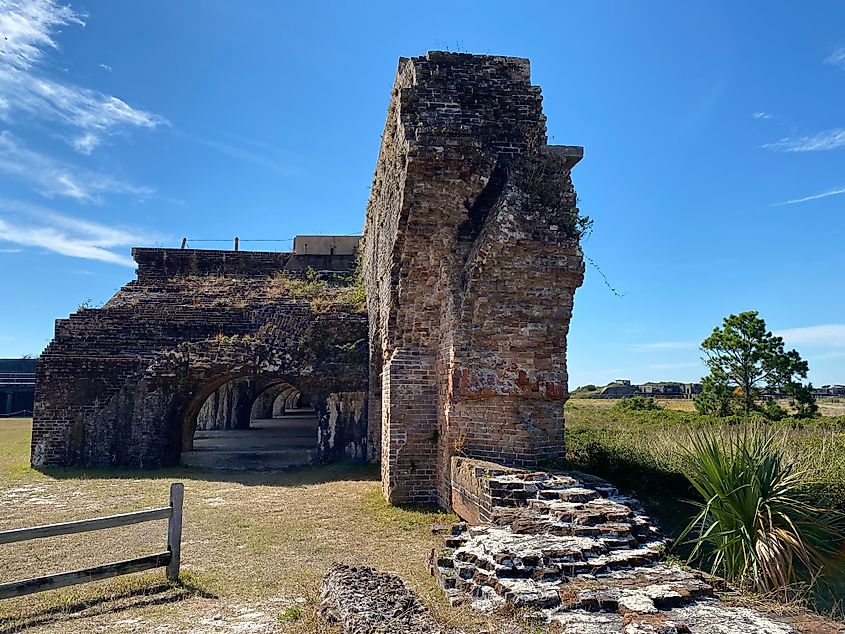
Gulf Islands National Seashore stretches along the Gulf of Mexico's barrier islands in Florida.
The Gulf Islands National Seashore, another one of Florida's national parks, is an expanse of elongated islands sitting along the Gulf of Mexico's coastlines of Florida and into Mississippi. It is a protected area that draws in tourists for its pristine beaches, historic sites, and diverse ecosystems. Encompassing over 160 miles of shoreline, this national seashore includes barrier islands, maritime forests, bayous, and historic forts that can still be checked out to this day.
In Florida, the seashore features the Santa Rosa and Perdido Key areas, known for their sugar-white sand beaches and crystal-clear waters. Enjoy world-class swimming, sunbathing, and beachcombing, as well as exploring the underwater world through snorkeling and scuba diving on your stop here. Dolphins, sea turtles, and numerous bird species are familiar sights while exploring the water of this area.
Fort Pickens, near Pensacola, is a prominent feature of the seashore. The fort played a significant role during the Civil War and remains a popular attraction for history enthusiasts.
Find the Best Natural Destinations Florida Has to Offer
Florida is built up of a collection of wonderful landscapes, from the vibrant marine life of the Florida Keys and the awe-inspiring formations of Devil’s Den to the crystal clear waters of Blue Spring State Park. Each destination is sure to give you an eye-opening and unique experience, showcasing Florida's natural beauty while highlighting the need for ongoing conservation efforts.
Whether diving into the depths of its springs, hiking along its coastlines, or observing its wildlife there is no shortage of things to see and do in the Sunshine State.











